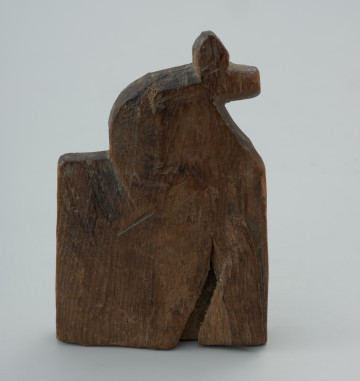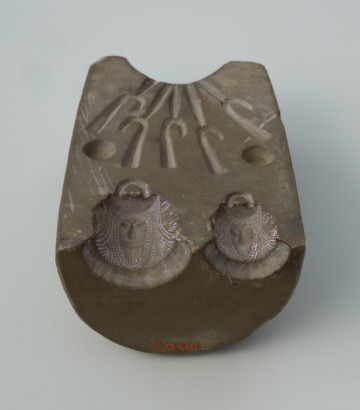
Figurine - ancestor
National Museum in Szczecin
Part of the collection: Middle Ages
Anthropomorphic figurines, usually wooden, with facial expressions, are referred to as idols associated with pagan beliefs. Excavations in Szczecin have yielded, among others, a seventeen-centimetre idol found in a cultural layer from the eleventh century. This type of figurine was described among others by Ebon, the hagiographer of St Otto of Bamberg, who also describes small idols made of gold, stored in wooden containers, carefully wrapped in cloth, displayed to the public during religious ceremonies. It is unknown to what extent these anthropomorphic miniatures made of precious metals were equivalent to the large statues of deities placed in temples. Research on early medieval idols has led some scholars to conclude that images of deities intended for cult-related activities within temples were made from non-ferrous metals. Wooden figurines, especially those that had the form of a handle, could have been associated with the performance of rituals, with vegetative or love magic. The introduction of the new Christian religion in Pomerania in the first half of the 12th century was connected, among other things, with the demolition of pagan corners and statues of chief deities and gods, which were burnt or burnt or sunk in the waters of rivers and lakes. Before this, however, their limbs were chopped off and their faces destroyed. The hagiographers of St Otto of Bamberg noted the presence of maiora et minora idols, major and minor deities. Occasional figurines of smaller deities - minora - have survived to our times. In this case, we would be talking about statues not so much for the use of temples or the whole community in general, but rather for "domestic" use, perhaps associated with the cult of the householder. The worship of the lower gods was no less important in everyday life than the worship of the higher gods. According to the accounts of some medieval chroniclers, the Slavs took small wooden figurines with them on their journeys and placed them in gardens and fields. The link between anthropomorphic idols and the performance of magic, well established in culture, has been shown by folklore and ethnographic research throughout the Slavic region.
Anna Bogumiła Kowalska
Author / creator
Dimensions
cały obiekt: height: 16.3 cm, width: 3.2 cm
Object type
cult object, figurine
Technique
sculpture, hand made, individual
Material
wood
Origin / acquisition method
field research
Creation time / dating
Creation / finding place
Owner
Muzeum Narodowe w Szczecinie
Identification number
Location / status

National Museum in Szczecin

National Museum in Szczecin

National Museum in Szczecin
DISCOVER this TOPIC
Museum of King Jan III's Palace at Wilanów
DISCOVER this PATH
Educational path